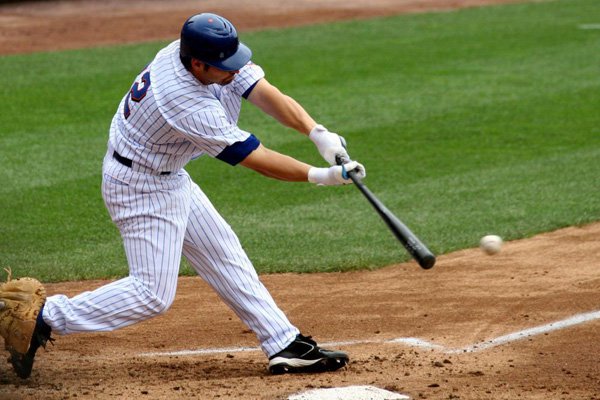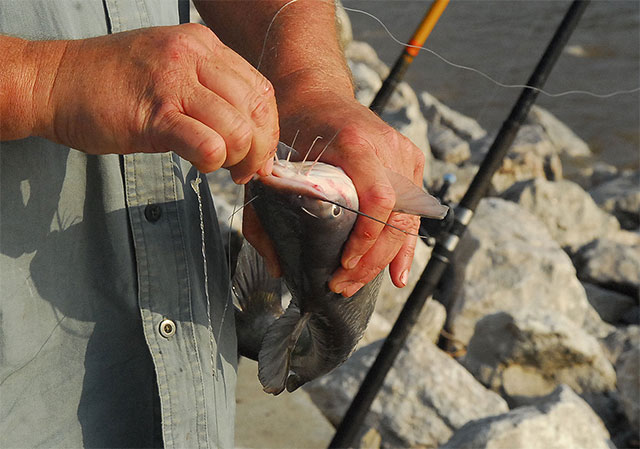Every year, in lakes and rivers around the country, flooded shoreline turns into a maze of inundated bushes, trees and weeds that provides bass with plenty of hiding places. Texas pro Alton Jones fishes reservoirs during flood stage and knows where to begin searching for bass that are predisposed to forage in backwaters. It's never easy, however.
"There's so much good-looking cover available, you have to pick which trees to fish and which to pass by, because there just isn't enough time in the day to flip all of them," he acknowledges. Here's how Jones narrows the search.
LIKELY HOLDING AREAS
Not all bass in a lake move into flooded areas to feed. If habitat requirements such as food and cover are met where they are, they stay put. As for those that do follow floodwaters to better pickings, Jones believes bass follow the same migration paths they use when a lake is at normal level. In flood stages, the Texas angler keys on areas close to creek channels, ditches and roadbeds. He believes bass migrate along such routes to reach newly flooded cover. The edges of forests, fencerows and the shoreline are other spots where Jones finds bass in flooding conditions.
"I don't like to fish the bushes between the inside and outside edges because often that can encompass an area that is a quarter mile from the outside edges of the bushes to the shore," notes Jones. "If fish are out in that labyrinth you might catch a few there, but you are going to spend a lot of time trying to put a bait in front of a bass."
The "edge factor" plays a key role when you're trying to find bass in a flooded jungle. Jones establishes a pattern by figuring out whether most bass are holding on the outside edges of trees along creek channels and forests or whether the fish have spread out along the inside edge of the shoreline. He then finds other places like the ones that first produced the most bites.
CLOSING IN
A good topographic map can be a pivotal tool for locating bass on flooded waterways. "It helps you see the major pathways and areas of the lake that have big bass populations whenever the lake is at normal level," suggests Jones, who avoids fishing areas that lack habitat at normal levels. Turbidity poses a problem during flooding conditions, so Jones searches for areas with the clearest water. He avoids fishing a reservoir's main tributary or major creeks because muddy runoff flows into these watersheds after heavy rains. The upper end of a main tributary usually features flat terrain and, during flood stage, the waters spread over too vast an area. So Jones concentrates on the lower section of a lake, where the water becomes more contained by the steeper shoreline.
Once through the thicker shoreline cover, Jones proceeds to fish every nook and cranny where he believes a bass might be hiding. Since he's limited to a confined area, Jones saturates a spot with multiple casts before moving.
KNOW YOUR TREES
A basic knowledge of forestry also comes in handy when you're searching for bass in a flooded jungle. When fishing in the southeast and Texas, Jones keys on pine and sweet gum trees. In other parts of the country, he finds bass hiding in trees such as sycamores and cottonwoods that grow close to the water's edge. He prefers areas where there are large flooded trees with exposed root systems. Bass favor such cover as ambush points, and will even spawn there if floodwaters stay for extended periods.
If a reservoir is in flood stage during the post-spawn or summer, Jones targets the thickest shallow cover he can find. "I love to fish vines, especially when the sun comes out," he says. On bright, sunny days, bass recuperating from the rigors of spawning burrow into brambles to rest, and from there they eventually ambush baitfish.
Fishing in a flooded jungle requires special deliveries, so Jones often pitches and flips his lures: "Most of the time you're working in close quarters and you might even have so many overhanging limbs that it will be difficult to make a full overhand cast."
The Texas angler prefers a 6-foot rod to the 7- or 7 1/2-foot models normally used for flipping and pitching. The shorter rod allows Jones to make more accurate presentations and prevents him from hitting overhanging limbs on the hookset. Heavy tackle is required for winching bass out of the thick cover, which is why Jones favors a Fenwick Techna AV 6-foot medium-heavy-action rod for his presentations and relies on 30- to 50-pound-test Spiderwire. If he's fishing a reservoir noted for big bass, Jones usually opts for the 50-pound-test superline. "Braided line is necessary to get the fish turned and headed in your direction," says Jones. "If the fish gets its head down in cover, it's all over unless you've got really stout line."
BACKWATER LURES
Jones selects lures that duplicate predominant forage, usually shad or crayfish. His favorite flipping lure is a Yum Garrett MegaTube (in watermelon seed or black neon) Texas-rigged with a 1/8- to 3/16-ounce bullet weight. A 3/8-ounce jig and Yum Chunk plastic trailer (black-and-blue) is another choice. When he wants to cover water quickly, Jones throws a white or white-and-chartreuse 3/8-ounce spinnerbait with gold tandem blades (either two willowleaf blades or a Colorado/willowleaf combination).
Bass holding in flooded cover rarely spook, even in the shallowest water. Jones thinks it's because the bass feel safe and there are a lot of new menu items that they're loath to leave. An angler can approach such fish and make short-range presentations even if the water isn't muddy.
If heavy rains turn the nearest fishery into a flooded jungle, don't despair. Instead, go fishing. Blaze a trail through the densest woods to discover aggressive bass in a spot where most other anglers would fear to float.
Follow the Trails Bass use the same types of migration routes to access backwater areas as they do in the main lake or river. Look for fencelines or ditches that drain the swamp or flooded area. The latter can be dynamite places to fish when the water is rising or falling back into the banks.
Pocket Shots Backwater areas usually consist of a labyrinth of dead-end openings and box canyons of inundated trees and bushes. Don't try to pick the easiest routes through the jungle. Instead, fish each pocket thoroughly, then back out and head for the next likely fishing hole. Look for the same type of cover that attracts bass when the lake is at normal level: fallen timber, tangles of vines and large live trees with big root wads at their bases.
Enjoy free football matches live

Get a Hot Look with Baseball Caps This Spring

Spring Rains Bring Silver Lining for Whiskerfish Anglers

Copyright © www.mycheapnfljerseys.com Outdoor sports All Rights Reserved